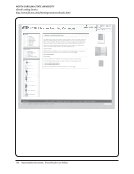SPEC Kit 313: E-book Collections · 19
Survey Questions And Responses
The SPEC survey on E-book Collections was designed by Catherine Anson, Director of Sponsored Research,
and Ruth R. Connell, Head, Collection Management and Systems Administration, John Carroll University.
These results are based on data submitted by 75 of the 123 ARL member libraries (61%) by the deadline of
May 8, 2009. The survey’s introductory text and questions are reproduced below, followed by the response
data and selected comments from the respondents.
Several factors are coming together heralding a wider acceptance of e-books in an academic setting. The open access journal
movement, Google Scholar, Project Gutenberg, and increasingly competitive e-book prices may encourage many libraries and
their users to adopt e-books. According to a 2008 article in the Chronicle of Higher Education, 69% of university research
libraries plan to increase spending on e-books over the next two years with a higher rate for non-US libraries. Comments to the
article highlight some of the obstacles faced by libraries: user unfamiliarity with e-books, an anti e-book sentiment, and a fear of
library obsolescence. This discussion reflects the debate on Amazon’s Kindle Forum and other Internet boards over e-books versus
print books, the best e-reader/format, and publishers’ digital rights management. However, users are increasingly accustomed
to and expect immediate access to materials and are comfortable with electronic formats thus making an e-book collection
attractive to an academic library and its clientele.
In addition to traditionally printed matter, publishers have been offering a variety of formats to libraries throughout the years:
microcard, microfiche, compact discs. E-books may be more than just the next step in formats that mimic but can’t compare
to print materials. Usability statistics may recognize that e-books are being used differently than print book collections, with
separate and distinct use, users, and management issues as compared to the physical print collection. However, restrictive and
non-standard vendor agreements may make it difficult for academic libraries to build e-book collections.
For the purposes of this survey, the term e-book is defined as: An electronic text publication, excluding journal publications and
textbooks, made available for any device (handheld or desk-bound) that includes a screen.*Modified from the definition proposed by Chris
Armstrong, Louise Edwards, and Ray Lonsdale in “Virtually There? E-books in UK Academic Libraries,” Program—Electronic Library and Information Systems 36,
no. 4 (2002): 216–27. E-version: http://eprints.rclis.org/5987/ p 2.
Therefore, e-books can be read online or downloaded in various formats (epub, pdf, mobi, etc.) to be read on various devices
(cell phones, PDAs, dedicated readers, tablet PCs, laptops, etc.). Works can be born digital, turned digital from print, released
simultaneously in digital and print, or any similar combination. E-books can be free, purchased singly, purchased as a package, or
leased.
This survey is designed to examine the current use of e-books in ARL member libraries their plans for implementing, increasing,
or decreasing access to e-books purchasing, cataloging, and collection management issues and issues in marketing to and in
usage by library clientele.
Survey Questions And Responses
The SPEC survey on E-book Collections was designed by Catherine Anson, Director of Sponsored Research,
and Ruth R. Connell, Head, Collection Management and Systems Administration, John Carroll University.
These results are based on data submitted by 75 of the 123 ARL member libraries (61%) by the deadline of
May 8, 2009. The survey’s introductory text and questions are reproduced below, followed by the response
data and selected comments from the respondents.
Several factors are coming together heralding a wider acceptance of e-books in an academic setting. The open access journal
movement, Google Scholar, Project Gutenberg, and increasingly competitive e-book prices may encourage many libraries and
their users to adopt e-books. According to a 2008 article in the Chronicle of Higher Education, 69% of university research
libraries plan to increase spending on e-books over the next two years with a higher rate for non-US libraries. Comments to the
article highlight some of the obstacles faced by libraries: user unfamiliarity with e-books, an anti e-book sentiment, and a fear of
library obsolescence. This discussion reflects the debate on Amazon’s Kindle Forum and other Internet boards over e-books versus
print books, the best e-reader/format, and publishers’ digital rights management. However, users are increasingly accustomed
to and expect immediate access to materials and are comfortable with electronic formats thus making an e-book collection
attractive to an academic library and its clientele.
In addition to traditionally printed matter, publishers have been offering a variety of formats to libraries throughout the years:
microcard, microfiche, compact discs. E-books may be more than just the next step in formats that mimic but can’t compare
to print materials. Usability statistics may recognize that e-books are being used differently than print book collections, with
separate and distinct use, users, and management issues as compared to the physical print collection. However, restrictive and
non-standard vendor agreements may make it difficult for academic libraries to build e-book collections.
For the purposes of this survey, the term e-book is defined as: An electronic text publication, excluding journal publications and
textbooks, made available for any device (handheld or desk-bound) that includes a screen.*Modified from the definition proposed by Chris
Armstrong, Louise Edwards, and Ray Lonsdale in “Virtually There? E-books in UK Academic Libraries,” Program—Electronic Library and Information Systems 36,
no. 4 (2002): 216–27. E-version: http://eprints.rclis.org/5987/ p 2.
Therefore, e-books can be read online or downloaded in various formats (epub, pdf, mobi, etc.) to be read on various devices
(cell phones, PDAs, dedicated readers, tablet PCs, laptops, etc.). Works can be born digital, turned digital from print, released
simultaneously in digital and print, or any similar combination. E-books can be free, purchased singly, purchased as a package, or
leased.
This survey is designed to examine the current use of e-books in ARL member libraries their plans for implementing, increasing,
or decreasing access to e-books purchasing, cataloging, and collection management issues and issues in marketing to and in
usage by library clientele.
























































































































































































